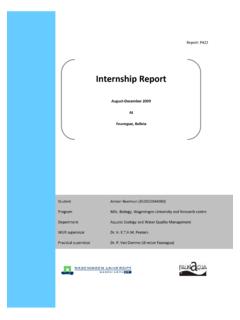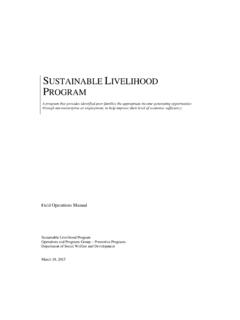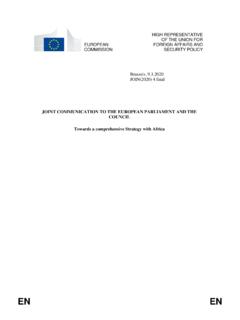Transcription of CHAPTER 4: CLIMATE CHANGE RISK AND VULNERABILITY …
1 CHAPTER 4: CLIMATE CHANGE RISK AND. VULNERABILITY ASSESSMENT. VULNERABILITY . CLIMATE CHANGE VULNERABILITY is defined as the propensity to be adversely affected by CLIMATE CHANGE (IPCC 2014). It encompasses a variety of concepts and elements including sensitivity or susceptibility to harm and lack of capacity to cope with and adapt to future changes (IPCC 2014)39. There are three key elements of VULNERABILITY : (i) exposure (ii) sensitivity (iii) adaptive capacity. On the other hand, risk is defined as the potential for consequence where something of value is at stake and where the outcome is uncertain, recognizing the diversity of values.
2 Risk is often represented as probability of occurrence of hazardous events (likelihood) multiplied by the impacts (or consequences) if these events occur. Risks result due to the interactions of VULNERABILITY , exposure, and hazards (IPCC, 2014). It is widely accepted that CLIMATE CHANGE may exacerbate far reaching consequences on ecosystems and pose developmental challenges (Ramachandran et al, 2016)40. Therefore, it is very essential to have a detailed analysis of the likely impacts and VULNERABILITY of CLIMATE CHANGE . This involves evaluation of hazards and VULNERABILITY . Quantitative indexes are often used to express VULNERABILITY (Roman et al.)
3 , 2016)41. VULNERABILITY of an area is purely dependent on its natural settings, its climatic and the socio-economic conditions. It is very necessary to understand the interactions of CLIMATE CHANGE impacts on all the sectors with changes in exposure and VULNERABILITY , as well as adaptation and mitigation actions affecting the same or a different sector, at regional or sub regional scales that vary across temporal and spatial scales (IPCC, 2014). Tamil Nadu is one of the extreme-events prone States in India that faces more extremities of cyclones and drought recurrently. In view of this, the following are the CLIMATE CHANGE VULNERABILITY studies across various sectors in Tamil Nadu.
4 39. IPCC (2014) Summary for Policymakers', in Edenhofer, O., Pichs-Madruga, R., Sokona, Y.,Farahani, E., Kadner, S., Seyboth, K., Adler, A., Baum, I., Brunner, S., Eickemeier, P., Kriemann, B., Savolainen, J., Schl mer, S., von Stechow, C., Zwickel, T. and Minx, (Eds.): CLIMATE CHANGE 2014: Mitigation of CLIMATE CHANGE . Contribution of working group III to the Fifth Assessment Report of the Intergovernmental Panel on CLIMATE CHANGE ,Cambridge University Press, Cambridge, UK and New York, NY, USA. 40. A. Ramachandran; Dhanya Praveen; P. Radhapriya; Divya; K. Remya; K. Palanivelu, (2016) VULNERABILITY and adaptation assessment a way forward for sustainable sectoral development in the purview of CLIMATE variability and CHANGE : insights from the coast of Tamil Nadu, India, International Journal of Global Warming 10(1/2/3):307, DOI: 41.
5 Roman, , Lynch, and Dominey-Howes, D. (2010) Uncovering the essence of the CLIMATE CHANGE adaptation problem a case study of the tourism sector at Alpine Shire, Victoria, Australia', tourism Planning &. Development, Vol. 7, No. 3, 252. 66. SECTORAL VULNERABILITY & IMPACTS. In the following section VULNERABILITY of each of the sectors is discussed sustainable Agriculture, Water Resources, Forest & Biodiversity and Coastal Area Management. VULNERABILITY studies have not been conducted for the Energy and sustainable Habitat sectors; hence only impacts are discussed for these sectors. CLIMATE CHANGE Impacts and VULNERABILITY on sustainable Agriculture CLIMATE CHANGE and agriculture are interrelated processes, both of which take place on a global scale.
6 CLIMATE CHANGE affects agriculture in a number of ways, including through changes in average temperatures, rainfall, and CLIMATE extremes ( , heat waves); changes in pests and diseases;. changes in atmospheric carbon dioxide and ground-level ozone concentrations; changes in the nutritional quality of some foods, and changes in sea level. CLIMATE CHANGE is already affecting agriculture, with effects unevenly distributed across the world. In fact, studies on the Agricultural VULNERABILITY of Tamil Nadu to CLIMATE CHANGE have shown that all districts in an agro climatic zone does not fall under the same category of VULNERABILITY which exemplifies the need for the State to prioritize research and development issues and effective decision making through Location-Performance- VULNERABILITY based adaptation strategies (Varadhan and Kumar 2015)42.
7 The Current Agriculture VULNERABILITY for the Districts of Tamil Nadu has been assessed by GIZ and Integrated Natural Resource Management (INRM) and is shown in Figure It is clearly explained that Chennai district has shown very high VULNERABILITY (There is no agriculture activity) which is located in the North Eastern zone of Tamil Nadu. Further, Ramanathapuram, Thoothukkudi, Virudhunagar, Dindigul, The Nilgiris, Sivaganga and Kanyakumari districts fall under high VULNERABILITY category. The major contributing factors include food grains yield, irrigated area, net sown area, fertilizer consumption, milk and egg production, low livestock and poultry population.
8 CLIMATE CHANGE Impact on Crop Varieties in Tamil Nadu The recent study simulated the crop yield under a possible CLIMATE CHANGE scenarios for the coastal areas of South India through the end of this century. The crop simulation model, the Decision Support System for Agrotechnology Transfer (DSSAT) , was used to understand the plausible impacts on the major crop yields of rice, groundnuts, and sugarcane under the trajectory. The findings reveal that under the RCP scenario there will be decreases in the major C3 and C4 crop yields in the study area as shown in Table This would affect not only the local food security, but the livelihood security as well (Ramachandran et al 2017)43.
9 42 Varadan, ; Kumar, P. Mapping agricultural VULNERABILITY of Tamil Nadu, India to CLIMATE CHANGE :A dynamic approach to take forward the VULNERABILITY assessment methodology. Clim. Chang. 2015, 129, 159 181. 43A. Ramachandran1 & A. Saleem Khan1 & K. Palanivelu1 & R. Prasannavenkatesh1N. Jayanthi1 (2017), Projection of CLIMATE CHANGE -induced sea-level rise for the coasts of Tamil Nadu and Puducherry, India using SimCLIM: a first step towards planning adaptation policies, J Coast Conserv (2017) 21:731 742 DOI. 67. Figure Agriculture VULNERABILITY map for districts of Tamil Nadu for current VULNERABILITY (Source: 2018).
10 68. Table Mean projected crop yield changes under control and CO2 simulations Projected Yield Year Control CO2 (538 ppm)Rice Rice 2010-2040 2041-2070 2071-2098 Groundnut 2010-2040 2041-2070 2071-2098 Sugarcane 2010-2040 2041-2070 No CHANGE 2071-2098 (Source: Ramachandran et al 2017). Maize: The CHANGE in CLIMATE is expected to create both positive as well as negative impacts on maize cultivation. Impact of maize yield was studied for major maize growing districts of Tamil Nadu using INFOCROP model for CLIMATE CHANGE scenarios developed for 2020, 2050 and 2080. (Geethalakshmi, 2009)44.








